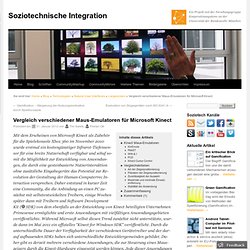Zoom
Trash

Kinect_calibration/technical. Description: Technical aspects of the Kinect device and its calibration Tutorial Level: ADVANCED Authors: Kurt Konolige, Patrick Mihelich Imager and projector placement The Kinect device has two cameras and one laser-based IR projector.

The figure below shows their placement on the device. This image is provided by iFixit. All the calibrations done below are based on IR and RGB images of chessboard patterns, using OpenCV's calibration routines. Depth calculation The IR camera and the IR projector form a stereo pair with a baseline of approximately 7.5 cm. Depth is calculated by triangulation against a known pattern from the projector. Disparity to depth relationship For a normal stereo system, the cameras are calibrated so that the rectified images are parallel and have corresponding horizontal lines. Z = b*f / d, The Kinect returns a raw disparity that is not normalized in this way, that is, a zero Kinect disparity does not correspond to infinite distance. Leap Motion.
RGBDToolkit. Kinect Dubstep. An open source implementation of KinectFusion - Point Cloud Library. Kinect Voxel Hands Demo. Gesture Controlled Pin Code Interface. Christian "Mio" Loclair Media. Kinect Projector Dance. Vergleich verschiedener Maus-Emulatoren für Microsoft Kinect. Mit dem Erscheinen von Microsoft Kinect als Zubehör für die Spielekonsole Xbox 360 im November 2010 wurde erstmal ein kostengünstiger Infrarot-Tiefensensor für eine breite Nutzerschaft verfügbar und schuf somit die Möglichkeit zur Entwicklung von Anwendungen, die durch eine gestenbasierte Nutzerinteraktion ohne zusätzliche Eingabegeräte das Potential zur Revolution der Gestaltung der Human-Computerrec Interaction versprechen.

Daher entstand in kurzer Zeit eine Community, die die Anbindung an einen PC zunächst mit selbstentwickelten Treibern, einige Wochen später dann mit Treibern und Software Development Kit (SDK) von dem ebenfalls an der Entwicklung von Kinect beteiligten Unternehmen Primesense ermöglichte und erste Anwendungen mit vielfältigen Anwendungsgebieten veröffentlichte. Delicode NI mate Tutorials: Controlling Traktor Pro. Microsoft LightSpace from MSR.
A Handle Bar Metaphor for Virtual Object Manipulation with Mid-Air Interaction (CHI-2012) Berkeley 3-D Object Dataset. HoloDesk - Direct 3D Interactions with a Situated See-Through Display. The Kinect effect: how Harmonix mastered Dance Central's menus. Dance Central has quickly emerged as one of the best-received titles for Microsoft's Kinect.

Not only is the game great, but the smaller details like the way the menu system works are also superior to the other current Kinect offerings. Since gesture-based controls are such a new frontier, the developers at Harmonix had a difficult time creating an intuitive control scheme for navigating menus. The solution? Creating lots of prototypes and simply seeing what worked. The major problem for Harmonix was that, aside from that one scene in Minority Report, there weren't any real solid examples that the team could look at for inspiration.
The main goal was to create a menu system that didn't make players wish they were using a controller instead. Another early prototype featured a virtual scroll wheel, something along the lines of the big wheel from The Price Is Right. Things went on like this for around two months. All that, just to create a menu. The awesomeness of the Dance Central UI. Synapse for Kinect Introduction. Full Body 3D Scanning with 16 Kinect Sensors in an Automated Booth. Fitnect - Interactive Virtual Fitting / Dressing Room application. 3D Facial Performance Capture using Kinect. Home 3D Body Scanning using the Kinect. OpenNI - OpenNI > Home. Flexible Action and Articulated Skeleton Toolkit (FAAST) Contributors Evan A.

Suma, Belinda Lange, Skip Rizzo, David Krum, and Mark Bolas Project Email Address: faast@ict.usc.edu 32-bit(recommended for most users) 64-bit(for advanced users) Note from Evan Suma, the developer of FAAST: I have recently transitioned to a faculty position at USC, and unfortunately that means I have very limited time for further development of the toolkit.
You may also view our online video gallery, which contains videos that demonstrate FAAST’s capabilities, as well as interesting applications that use the toolkit. Have a Kinect for Windows v2? We have developed an experimental version of FAAST with support for the Kinect for Windows v2, available for download here (64-bit only). Recent News December 12, 2013 FAAST 1.2 has been released, adding compatibility for Windows 8. Summary FAAST is middleware to facilitate integration of full-body control with games and VR applications using either OpenNI or the Microsoft Kinect for Windows skeleton tracking software. E. Support. Here Are Some Crazy Things People Are Doing With Kinect. This Kinect Hack Is Actually Useful. Asus WAVI Xtion to Hit the Market in October. Xbox Kinect Licht-Gestensteuerung über Crestron Smart-Home. Gira und Apple perfekt integriert.